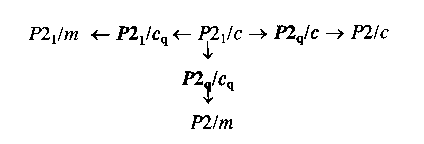ON THE ORIGIN OF TRANSITIONAL SPACE GROUPS IN BETWEEN TRICLINIC AND PSEUDO-MONOCLINIC CRYSTALS
Alajos Kálmán
Institute of Chemistry, Chemical Research Center, Hungarian Academy of Sciences, Budapest P.O.B. 17., H-1525, Hungary, E-mail: akalman@cric.chemres.hu
Keywords: asymmetric translation, pseudosymmetries, symmetry migration
Symmetry operators with translation of 1/4->3/4->1/4
type have been discovered in the course of a symmetry analysis
[1] of triclinic crystals reported with space group P and Z=8 (four molecules
in the asymmetric unit). More than a half dozen triclinic
crystals (e.g. EXCHLN, KUGWUE, YIHHOM, etc.) have been found
among the structures retrieved from CSD (January 1997 release) to
exhibit pseudosymmetries: *21 and *c with
regular translation:
![]()
but mixed frequently with unusual screw axes and glide planes showing irregular translation:
![]()
They are labelled with *2q and *cq, and termed as secondary pseudosymmetries [1]. These symmetries were also revealed in four structures which had beeen shown to be centred monoclinic by a compulsory transformation test [2] seeking for higher crystal systems. Remarkably, in CIJSAP, DILFEJ, and VARCOG with relatively high figure of merit: (fm = 0.267, 0.114 and 0.490, respectively) the eight molecules pertaining to the original triclinic unit cell are located on two orbits formed solely by these secondary pseudosymmetries, which topologically can be described by a symmetry triplet:
2q(1/8,Y,1/4) <--> nq(Xq,1/8, Z)
= (0,0,0) (1)
where q = 1/4->3/4->1/4, while X,Y,Z indicate the
infinite extension(s) of the commutative (<->) operators
and (0,0,0) is one of
the crystallographic inversion centers, located in the origin. In
contrast, only DIYMED with the lowest fm = 0.025 could be
transformed into a unit cell to which a centred crystallographic
space group C2/c (No. 15) could be assigned. However, in
this unit cell, parallel with the regular orbit 2/c, a
simpler irregular pair 21/cq, is also retained. These two orbits are
separated by y = 1/8. From this and Eq. (1) it follows
that the origin of asymmetric translations along with and/or
perpendicular to the orthogonal b axis is the unusual (2n-1)1/8 position(s) occupied occasionally by symmetry operators,
either regular or irregular or both. Topologically three
irregular orbits
(1): 21/cq, (2): 2q/c and (3): 2q/cq
can be inferred from the most popular space group P21/c (No. 14) if parameters a, b, g are altered between 0 and 1/4
(±1/2) in the generalized triplet 2t(a,Y,b) <-->
ct(X,g,Z)=(0,0,0), where the
translation t is either regular (0, or
1/2) or irregular (1/4 ->3/4), while X,Y,Z are as given above.
When parameter b or g = 1 is alternatively shifted to 0 then two
other standard space groups P21/m
(No. 11) and P2/c (No. 13) are defined. Their
triplets

indicate that (0,0,0)
is located either on 21 or c.
However, when the migration of these symmetries stops at the
midpoint between 0 and 1/4 then two new transitional space
groups

are generated. They are equal to the 1-st and 2-nd combinations of the irregular symmetries recognized in the above mentioned triclinic and pseudo-monoclinic crystals. Naturally, the 3-rd pair of these symmetries can also be regarded as a transitional space group between P21/c and P2/m (No 10). These symmmetry migrations can be summarized as follows:

As observed, molecules cannot develope such space groups in perfect form. At least partly, they are always formed by pseudosymmetries. However, the transitions between triclinic and pseudo-monoclinic forms are well described by such irregular symmetries in centred unit cells approaching either to the canonical space group C2/m and or C2/c. By all means these transitional space groups (two of them are revealed in the crystals investigated) create a novel subdivision of the 230 space groups.
The advantage of transitional space groups in the structures mentioned above can be attributed to the duplication of the secondary pseudosymmetries with one or two coordinates of (2n-1)1/8. They give rise simultaneously to the loss of the half of their function within and around the unit cell. In other words, the function of a glide plane g at 1/4, is divided symmetrically by its twin form located at 1/4±1/8, respectively. This seems to help the rigid and bulky molecules against their diminished self-complementarity to reach an optimum of close packing.
This work has been sponsored by the Hungarian Res. Fund Grant No. OTKA T023212.
[1] Kálmán, A.& Argay, Gy. (1998). Acta
Cryst B54. in the press.
[2] Spek, A. L. (1988). J. Appl. Cryst. 21,
578-579.